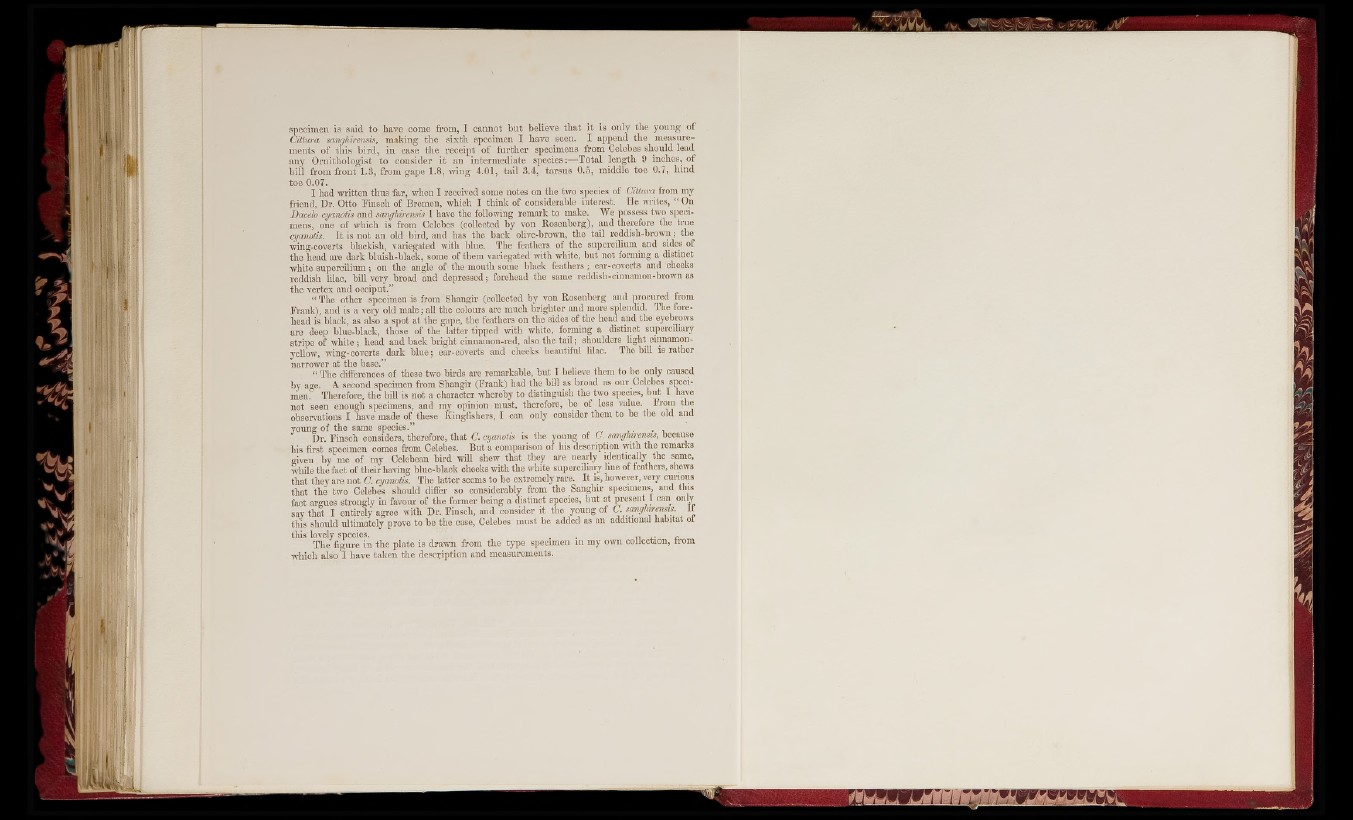
specimen is said to liave come from, I c annot b u t believe th a t i t is only the y oung of
Cittura sanghirensis, making th e s ix th specimen I have seen. I append the measurem
ents o f th is b ird , in case th e receipt o f fu rth e r specimens from Celebes should lead
any O rn ith o lo g is t to consider i t an in termed iate sp ecie s:— To ta l len g th 9 inches, o f
b ill from fro n t 1.3, from gape 1.8, wing 4.01, ta il 3.4, tarsu s 0.5, middle toe 0.7, h in d
toe 0.07.
I had written thus far, when I received some notes on the two species of Cittura from my
friend, Dr. Otto Finsch of Bremen, which I think of considerable interest. He writes, “ Op
Dacelo cyanotis aud sanghirensis I have the following remark to make. We possess two specimens,
one of which is from Celebes (collected by von Rosenberg), and therefore tlie true
cyanotis. I t is not an old bird, aud has the back olive-brown, the tail reddish-brown; the
wing-coverts blackish, vaiiegated with blue. The feathers of the supercilium and sides of
the head are dark bluish-black, some of them variegated with Avhite, but not forming a distinct
white supercilium ; on the angle of the mouth some black feathers; ear-coverts and cheeks
reddish lilac, bill very broad aud depressed; forehead the same rcddish-cinnamon-browu as
the vertex and occiput.”
“ The other specimen is from Shangir (collected by von Rosenberg and procured irom
Frank), and is a very old m ale ; all the colours ave much brighter and more splendid. The forehead
is black, as also a spot at the gape, the feathers on the sides of the head and the eyebrows
are deep blue-black, those of the latter tipped with white, forming a distinct superciliary
stripe of white ; head and back bright cinnamon-red, also the tail; shoulders light cinnamon-
yellow, wing-coverts dark b lu e; ear-coverts and cheeks beautiful lilac. The bill is rather
narrower at the base.” , i i j
“ The differences of these two birds are remarkable, b u t i believe them to be only caused
by ao-e. A second specimen from Shangir (Frank) had the bill as broad as our Celebes speci-
menf* Therefore, the bill is not a character whereby to distmguish the two species, but I have
not seen enough specimens, and my opinion must, therefore, be of less value. From the
observations I have made of these Kingfishers, I can only consider them to be the old and
young of the same species.”
Dr. Finsch considers, therefore, th at C. cyanotis is the of C. sanghirensis, because
his first specimen comes from Celebes. But a comparison of his description with the remarks
given by me of my Celebean b ird will shew th at they are nearly identically the same,
while the fact of their having blue-black cheeks w ith the white superciliary line of feathers, shews
that they are not C. cyanotis. The latter seems to he extremely rare. It is, however, very curious
th at the two Celebes should differ so considerably from the Sanghir specimens and this
fact argues strongly in favour of the former being a distinct species, b u t at present 1 can only
say th at I entirely agree with Dr. Finsch, and consider it the young of C. sajnghrmsw. If
this should ultimately prove to he the case, Celebes must be added as an additional habitat ot
this lovely species. . »
T h e figure in th e p late is drawn from th e tyiie specimen in my own collection, from
which also I have tak en th e d escription and measurements.